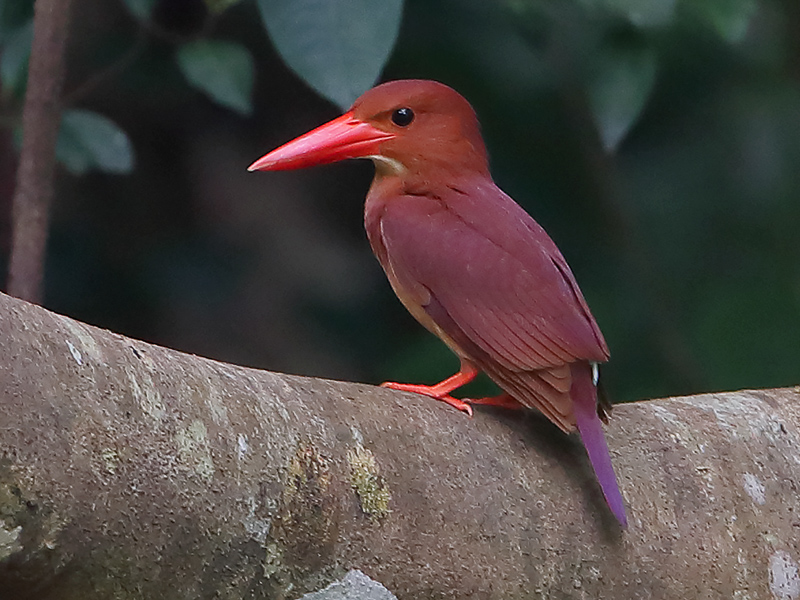Ruddy Kingfisher Halcyon coromanda 赤翡翠
Category I. Accidental.
IDENTIFICATION

Jun. 2018, Okinawa, Japan. Michelle and Peter Wong.
25-27 cm. Distinctive medium to large kingfisher with fairly large rose-red bill. The head is rusty coloured and highlights a dark eye, the mantle, back and tail are purplish, while the rump is contrastingly azure. The underparts are pale to mid-orange.
VOCALISATIONS
The flight call is a disyllabic ‘weet-too’, while the song is a whistled trill that speeds up terminally.
DISTRIBUTION & HABITAT PREFERENCE
The sole record occurred on the migrant hotspot of Po Toi.
OCCURRENCE
One on Po Toi on 18th and 21 May (Talbot and Cheung 2010).
BEHAVIOUR, FORAGING & DIET
The bird seen in HK was shy and elusive, which is typical of the species.
RANGE & SYSTEMATICS
Migratory populations breed in northeast China, the Korean peninsula and most of Japan, as well as in northeast India and northwest Myanmar; it is present all year in Indochina, southeast Asia, Sumatra, Borneo and Sulawesi, and in winter in the Philippines (Woodall 2020).
In China it is a rare east coast migrant and breeds in the far northeast. Cheng (1987) described Ruddy Kingfisher as “very rare” in China and listed three subspecies: H. c. coromanda resident in southern Yunnan, H. c. bangsi resident on Lanyu Islet, Taiwan and H. c. major breeding in northeast provinces including the Changbai Mountains and a migrant through Henan, Shaweishan Is., Fuzhou and Taiwan. Fu (1937) stated it was a summer visitor in south Henan. In addition, there is a winter record from Guangdong in December 1917.
There are ten subspecies, of which two are migratory and more likely to occur in HK. H. c. major breeds in northeast China, the Korean peninsula and mainland Japan, while H. c. bangsi breeds in the Ryukyu and Lanyu Islands, and Taiwan. Both winter the Philippines, Borneo and Sulawesi.
CONSERVATION STATUS
IUCN: Least Concern. Population trend decreasing.
Cheng, T. H. (1987). A Synopsis of the Avifauna of China. Science Press, Beijing.
Fu, T. S. (1937). L’etude des Oiseaux du Ho-nan. Langres: Imprimerie Moderne. [In French]
Talbot, G. and J. A. M. Cheung (2010). Ruddy Kingfisher Halcyon coromanda on Po Toi Island. Hong Kong Bird Report 2006: 197-199.
Woodall, P. F. (2020). Ruddy Kingfisher (Halcyon coromanda), version 1.0. In Birds of the World (J. del Hoyo, A. Elliott, J. Sargatal, D. A. Christie, and E. de Juana, Editors). Cornell Lab of Ornithology, Ithaca, NY, USA. https://doi.org/10.2173/bow.rudkin1.01

